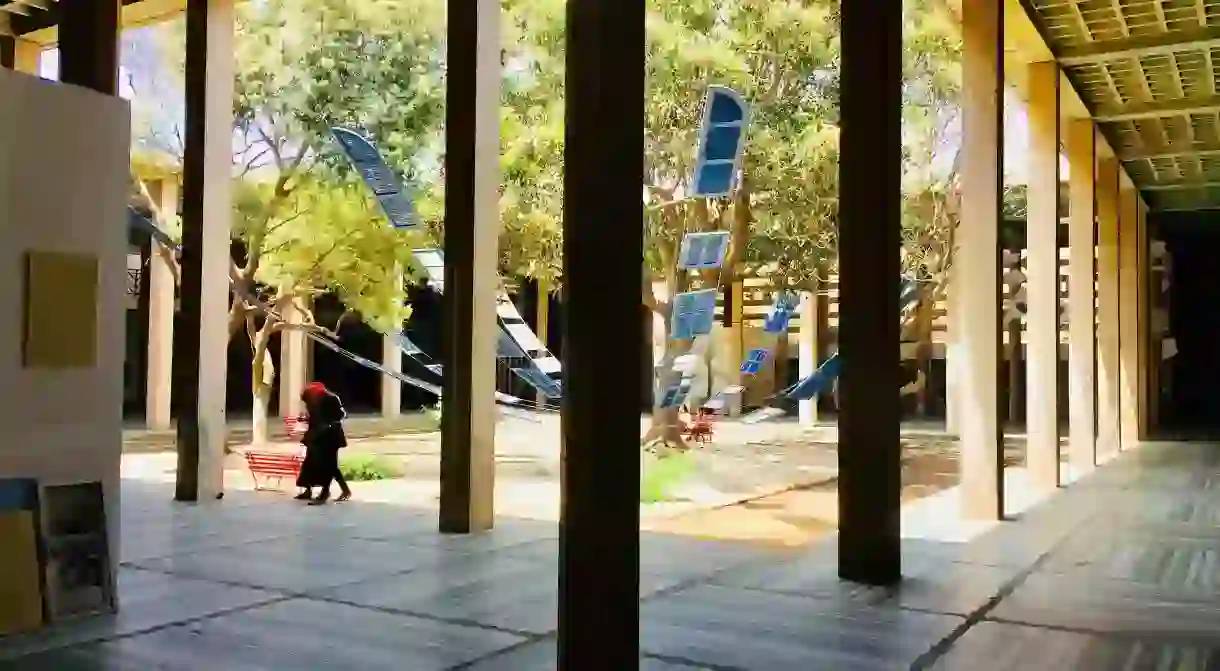Dak’Art: Why the Dakar Biennale is the Place for Art

Every two years, Dakar is flooded with a tsunami of colour as the month-long Biennale comes to town. Public and private spaces open up to welcome 30,000 visitors from across the world, but what have they actually come to see? And why is it so important?
The concept of the Biennale
Conceived as a celebration of literature, craft and visual arts in 1989, the Biennale has focused on contemporary African art since 1996 and has evolved into the largest show of its kind on the continent.
One of Africa’s 10 best cultural events, Dak’Art has been split into two distinct parts since 2002: the IN (those that follow that year’s theme) and the OFF (those that don’t). The former showcases internationally-acclaimed artists in buildings of national importance, as well as those previously not open to the public, such as the house of sculptor Ousmane Sow.

In 2018, the largest IN exhibition took place in the the brutalist-style former Palace of Justice, which opened its wide atriums and courtyards to display an exhibition on the ‘New Humanity’, featuring 75 artists from 33 countries.

The OFF is a different beast altogether, and for many is the beating heart of the Biennale. Encompassing 320 exhibitions from 1,000 featured artists, the OFF is quite rightly described as the Biennale’s ‘playground’, with a myriad of local and African artists displaying their eclectic works in suitably varied locations, such as restaurants, embassies, libraries, bus depots, hospitals, beaches and clothes shops; in other words, anywhere and everywhere.
This decentralisation – and the subsequent need to tame the streets, districts, and transport of Dakar – is just one of the many reasons why the Biennale is so much more than an art show.

Giving a voice to Africa and its diaspora
Art is one of the oldest forms of social commentary, long giving artists a voice and audiences sight. Dak’Art harnesses this power, using culture as a mechanism to promote values, tackle prejudices and inform the outside world about the continent’s people and customs.
As such, a theme is chosen for each Biennale that resonates with the continent at large and 2018 focused on the idea of ‘L’Heure Rouge’ (The Red Hour): an expression characterised by Franco-Caribbean writer Aimé Césaire to resemble emancipation, freedom and responsibility. Apt, given Africa’s turbulent past, misunderstood present, and rapidly expanding future.

Promoting African artists to the world
Visitors, journalists and art world aficionados descend on this West African hub during the Biennale, with museums such as the Pompidou Centre and the Tate in London sending representatives. For international artists, there are chances to win competitions to increase their standing, such as the Grand Prix Léopold-Sédar-Senghor, which in 2018 was awarded to Franco-Beninese photographer Laeïla Adjovi for her series on breaking free.

But, again, it’s in the ocean of OFF where the Biennale makes the biggest splash. From hotels to markets, African artists display their work to unprecedented global and even local audiences; an exposure that can transform their lives. Defo, for example, is a Dakar-born artist who honed his kaleidoscopic style at the Villages des Arts. With the attention bestowed by shows like the Biennale, he now commands thousands for his work.

Inclusiveness at the core of the Biennale
Unlike its Venice and Berlin cousins, the Dakar Biennale prides itself on inclusivity. Every exhibition, whether IN or OFF, is free to attend and with freedom to explore and touch once inside; the draconian rules of some western museums is a distant nightmare.
Meanwhile, with OFF locations in every single quarter of Dakar, locals make up a much higher proportion of those visiting than anyone else, while in 2018 each commune in Dakar hosted a ‘Barak’, where local residents – especially women and children – were invited to show what defines them in art.

But, it’s not just about the audience. The exhibitions are an explosion of styles, materials and techniques: sound installations to videos, hand-woven quilts to bronze sculptures, paintings, photography, drift wood carvings. Some are interactive, some interpretive. Some light, some dark, some loud, some silent. In one room, a recreation of a Maghreb Disco, in another, a piece made from empty drug packets. No matter your oeuvre, you can find your space at Dak’Art.

How to visit
Treat the ‘IN’ exhibitions like you would a museum – they can take anywhere between one to four hours – while the OFFs are much more of a 20-minute smash and grab. Although the Biennale is a month-long event, some of the OFFs only last for a few weeks, so it’s best to check the programme (pick up a hard copy at an IN exhibition) in advance. Then, simply check the map, find a grouping of exhibitions you like the look of and head to that district. Easy as pie.













